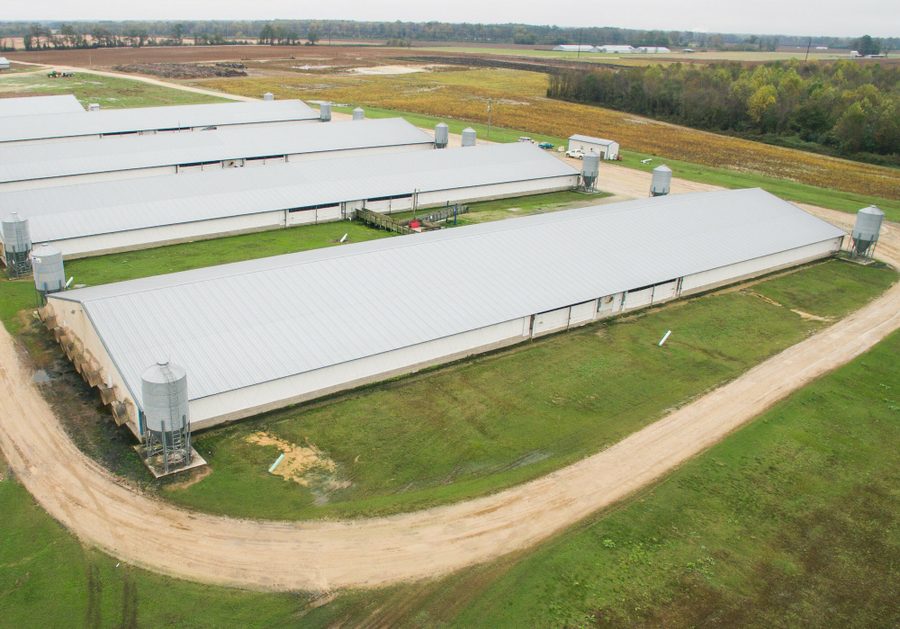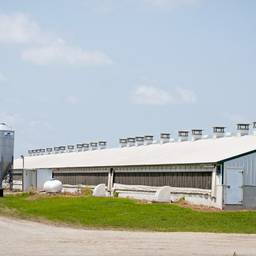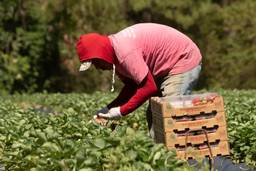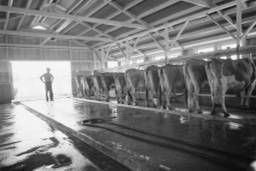Construction Companies Are Exploiting Agricultural Visas to Underpay Workers. The Supreme Court Could Change That.
By bringing in H-2A visa workers to construct hog confinement facilities, companies can dodge overtime pay and undercut local construction workers. One company has asked the Supreme Court to weigh in.
Sky Chadde and Ryan Murphy

Jose Ageo Luna Vanegas first worked for Signet Builders in the early 2000s. Hired on a temporary labor visa, he traveled from Mexico to U.S. job sites. The hours were long, but he was paid overtime. Years later, around 2017, Signet hired him again. This time, he received no overtime pay.
That’s when he “started asking questions,” his attorney, Jennifer Zimmermann, said.
The work was largely the same. His visa was different.
Originally, Luna Vanegas was hired on an H-2B visa. Various industries use the visas to fill labor shortages. A hotel facing a busy summer might hire foreign maids, for instance. But, when Signet hired him for his second stint with the company, he was on an H-2A visa. It’s reserved for agriculture work. H-2B workers are eligible for overtime pay, but H-2A workers in many states are not because federal law exempts agricultural work from overtime.
Since at least 2008, the federal government has allowed construction companies to use H-2A labor to build livestock confinements, and the practice has only grown since then. However, following his drop in pay, Luna Vanegas sued, alleging his rights were violated. Earlier this year, Signet asked the U.S. Supreme Court to intervene to protect its business model.
The question Signet wants the court to answer is whether the company, as a builder of livestock confinements (also known as concentrated animal feeding operations, or CAFOs), are engaged in “agricultural” work. The issue is murkier than it first appears. What counts as agriculture for employment purposes has perplexed lawmakers and courts for decades.
The agriculture industry, including lobbying heavyweights, said the stakes are high. The industry’s exemption from overtime pay stems from concessions in the 1930s to Southern lawmakers at a time when most farm workers were Black. Today, industry groups argue that if workers who build livestock confinements had to be paid overtime, that would hurt producers and, ultimately, lead to higher prices for consumers.
But some in the construction industry said using H-2A labor is an unfair competitive advantage. Domestic construction workers make about $18 an hour, roughly $4 more on average than H-2A workers doing construction jobs. H-2A workers also do not pay Social Security and Medicare taxes, meaning employers avoid paying taxes on those, as well.
An Illinois construction company that only used domestic labor estimated it could have saved more than $150,000 on one project on overtime expenses and payroll taxes if it hired H-2A workers instead, according to court records. Open for decades, the business shuttered in 2019.
Also, hiring Luna Vanegas on a different visa decreased his earning potential. In 2019, the last year he worked for Signet, construction workers on H-2B visas earned, on average, about $16 an hour, according to federal data. H-2A workers doing the same job made about $2 less per hour.
Signet’s lawyer, Paul Clement, didn’t return multiple requests for comment over the past few weeks. Clement — a former solicitor general who has gone on to represent Hobby Lobby and the National Rifle Association — has argued more than 100 cases before the Supreme Court. More recently, he represented Tyson Foods against a lawsuit brought by family members of employees who died from Covid-19 contracted in Tyson’s meatpacking plants.
Signet also did not respond to requests for comment.
In an amicus brief to the Supreme Court, the National Pork Producers Council, which represents hog growers that rely on large livestock confinements, defended the agriculture exemption and its application to workers such as Luna Vanegas.
“The exemption has become a crucial part of a broader national policy encouraging more, and more cost-effective, production, designed to ensure the ability of the United States to feed both itself and to utilize its surplus production to feed the world,” it said. The NPPC didn’t respond to requests for comment.
Part of the debate is whether building on a farm is “construction” or “agriculture.”
Building livestock confinements is clearly agricultural because the work is “exclusively on an ag producers’ property,” said Shawn D. Twing, counsel for the Texas Cattle Feeders Association, a group that represents the growers who supply feed to the livestock industry. The group also submitted an amicus brief to the Supreme Court.
Luna Vanegas’s attorneys, however, disagreed. At no point during his employment did he interact with any animals. At all times, they said, he was clearly only engaged in construction. (Through his attorneys, Luna Vanegas declined to be interviewed.)
The agriculture industry has evolved considerably since Congress codified its definition in the Fair Labor Standards Act of 1938. Today, most farms are highly specialized and technical endeavors. Inside livestock confinements, for instance, computers monitor various signs of animal health. Producers tout advancements in keeping diseases out.
Given that, Twing said it is a little strange to hinge arguments on decades-old language.
“We’re using some terminology that goes back to the thirties, so it is a little awkward. But the way that the agricultural business has developed, the exemption from overtime has been a major part of the business model,” he said, adding workers’ economic conditions have improved as agriculture industrialized. “If all of a sudden the ag exemption is removed, then you’re adding a considerable cost. That could be detrimental not only to the producers, but to the employees.”
Luna Vanegas filed his lawsuit in 2021. Dismissed originally, it was resurrected in an appeals court. The case continues in federal court, and the parties are going through discovery, said Zimmermann, an attorney with Legal Action of Wisconsin. She’s one of a team of lawyers representing Luna Vanegas.
In March, Signet filed its request for a hearing with the Supreme Court. There could be a ruling on whether the justices hear the case later this year.
A ‘race-neutral proxy’
The exemption from overtime pay for agricultural workers has endured for decades, even during periods of pro-worker activity. It was inscribed into law by New Deal legislation, and, even as the Civil Rights Movement expanded labor rights, it survived.
In the 1930s, as the Great Depression raged on, lawmakers mulled how to improve job conditions. Many labored long hours for inadequate pay. The solution was the Fair Labor Standards Act.
It set a minimum wage, enacted the eight-hour workday and guaranteed time-and-a-half for overtime. A few industries were excluded from certain protections. One was agriculture.
One reason farmers didn’t have to pay their workers overtime was the lobbying of large producers. It would have greatly affected their business model, according to a 2005 research article on the act’s history.
Lawmakers also feared burdening small family farms. Regulations applying to an assembly line should not be applied to the seasonal nature of farming, some reasoned. (The 2005 article states these concerns were “exaggerated and unsubstantiated,” as truly small farms would have been exempt from the regulations, much like how farms of certain sizes are exempt from federal safety regulations today.)
But historians recognized another reason: At the time, most farm workers were Black, a remnant of slavery. The act’s language did not explicitly exclude Black people, but the exclusion was “well-understood as a race-neutral proxy,” according to a 2011 study.
Decades after it was enacted, the agricultural exemption became a central part of the Civil Rights Movement. During the 1963 March on Washington, a program listed 10 core demands including broadening the Fair Labor Standards Act to “all areas of employment which are presently excluded.”
In 1966, Congress added protections for some industries that were absent from the original legislation. Agriculture, however, remained exempt.
The exemption can lead to unsafe working conditions, as small crews could be forced to work longer hours, often in extreme heat with few breaks, Rebecca Dixon, the executive director of the National Employment Law Project, testified before Congress in 2021.
“The (act’s) continued exclusion of farm workers from overtime pay enables and incentivizes farms to require farm workers to labor from sunrise to sunset,” Dixon said, “regardless of the hours required or the toll that places on farm workers’ bodies and family lives.”
‘Incident to or in conjunction with’
Beyond limiting the earning potential of farm workers, the Fair Labor Standards Act has had another long-lasting impact — its vague definition of agriculture.
As the definition was debated, lawmakers wondered what kind of work the exemption would cover. Would a crew that threshed wheat be considered agriculture, even though they were not, technically, farmers? The debate’s purpose seemed to be to include as many workers within the exemption as possible, according to the 2005 research article.
Eventually, Congress agreed, without controversy, that farming is the growing of crops and the raising of animals. But, in language that spurs debate today, Congress added farming is also anything that is “incident to or in conjunction with” farming.
In 1949, the Supreme Court weighed in, setting a precedent that both Signet’s and Luna Vanegas’s attorneys cited in their briefs to the highest court.
Years earlier, a group of Colorado farmers created an irrigation company to deliver water to their fields. Although founded by farmers, the company’s main purpose was collecting, storing and distributing water.
The court — led by Justice Hugo Black, who as a U.S. senator sponsored the original legislation that became the Fair Labor Standards Act — framed the issue this way: No endeavor should be considered agriculture by its “necessity to the activity of agriculture.” Instead, the question is whether that endeavor is an “independent productive activity.”
To test this, the court differentiated between two kinds of agriculture. “Primary” is the basic core of farming: growing crops and raising livestock.
The court defined “secondary” agriculture as an activity that may not be agricultural in and of itself but that is necessary to the practice of agriculture. It’s any activity that’s “incident to” farming.
Black’s Supreme Court found the irrigation company was not secondary agriculture. It was, in fact, an independent productive activity.
While the company built canals and provided the water, the farmer, not a company employee, actually irrigated the fields. With that, the company’s employees were eligible for overtime pay.
The 1949 case, known as Farmers Reservoir, essentially ruled that any secondary agriculture activities — anything incidental to or in conjunction with agriculture — must be performed by a farmer or on a farm, according to the 2005 research article.
“If the employer does not own the farm or if the employees do not directly work for the farmer, the agricultural exemption is inapplicable,” the article states.
In the case before the Supreme Court now, Signet is arguing it is performing secondary agriculture. It builds structures necessary to farming, and it is performing that service on a farm, it said in court filings.
Luna Vanegas’s attorneys say that’s incorrect. One reason Signet can’t be engaged in agricultural work is because it’s a subcontractor — typically, a farmer hires a construction company, and then that company contracts with Signet or a similar business to perform a specific part of construction, according to court documents.
Signet has “falsely” indicated it worked for a “farm company,” when it really worked for a general construction contractor, the attorneys alleged in court documents.
(Signet and its lawyer, Clement, did not return requests for comment.)
Forced out of business
The use of H-2A labor for some projects, and the overtime exemption that accompanies it, had devastating financial effects on at least one company, according to court records.
In the mid-2000s, Mary Wilson bought Michel Concrete Construction, a Springfield, Illinois, business, from her father. Michel had a wide array of clients, but its inability to compete for jobs from its agricultural clients ultimately did the company in, according to court filings. (Through her lawyers, Wilson declined to be interviewed.)
Around 2010, Wilson bid on a project in a remote part of Illinois. Another company, Iowa-based Alewelt Concrete, also bid, but it was “suspiciously” low, Wilson recounted in an amicus brief in the Signet case.
In its cost estimate, Alewelt factored in using H-2A labor — meaning it didn’t have to pay overtime or payroll taxes. Wilson, on the other hand, employed domestic workers. She had to pay both.
Alewelt had requested H-2B labor before for its business pouring concrete for livestock confinements, but, in 2008, it wanted to change. It requested H-2A visas from the U.S. Department of Labor, but the agency denied the request.
After the company appealed, the labor department agreed it was engaged in agricultural work. In what was apparently the first time the federal government sanctioned H-2A labor for building livestock confinements, Alewelt was allowed to hire H-2A workers.
In order to win the contract against Alewelt, Wilson reduced her bid, costing the company and her domestic workforce money, according to court filings.
Alewelt, which filed an amicus brief supporting Signet’s position before the Supreme Court, did not respond to requests for comment.
Over the next few years, competing with Alewelt continued to take its toll on Wilson’s company. She accepted another job at a lower price because the company “badly needed the work,” she said in her brief. Even then, though, Wilson struggled to compete with the cost-savings Alewelt could provide customers.
On one project, Alewelt offered to pay its employees $11.10 an hour, according to Wilson’s account. That was $5 less than what Wilson paid her employees, not counting the overtime they were due.
If Wilson had hired H-2A workers, she could have saved more than $100,000 in wages and more than $50,000 in payroll taxes.
As Alewelt continued to expand, working on 3,500 farms in the past decade, Wilson’s company began to falter. In 2019, she decided she could no longer compete.
It’s unclear how stories such as Wilson’s could play into any potential Supreme Court decision, or into whether the court even decides to hear the case. But the case in the lower court could have potential impact on other workers like Luna Vanegas, Zimmermann, his lawyer, said.
“He believes that workers doing the construction work on farms should be paid overtime premiums,” she said. “He sees this broader impact. This (case) could potentially affect other workers doing the same work.”
This article was originally published by Investigate Midwest.
Investigate Midwest is an independent, nonprofit newsroom. Our mission is to serve the public interest by exposing dangerous and costly practices of influential agricultural corporations and institutions through in-depth and data-driven investigative journalism.Visit us online at www.investigatemidwest.org
Sky Chadde is the managing editor for Investigate Midwest. Previously, Chadde was the Center’s USA TODAY Agriculture Data Fellow. In 2019, he graduated from the Missouri School of Journalism with a master’s degree in investigative reporting. He’s covered Missouri state government for the Columbia Missourian and the St. Louis Post-Dispatch. Before grad school, he was a reporter in Texas, covering local governments and law enforcement. At Investigate Midwest, he focuses on data journalism.
Ryan Murphy is a Gary Marx Journalism Fund intern at Investigate Midwest.








